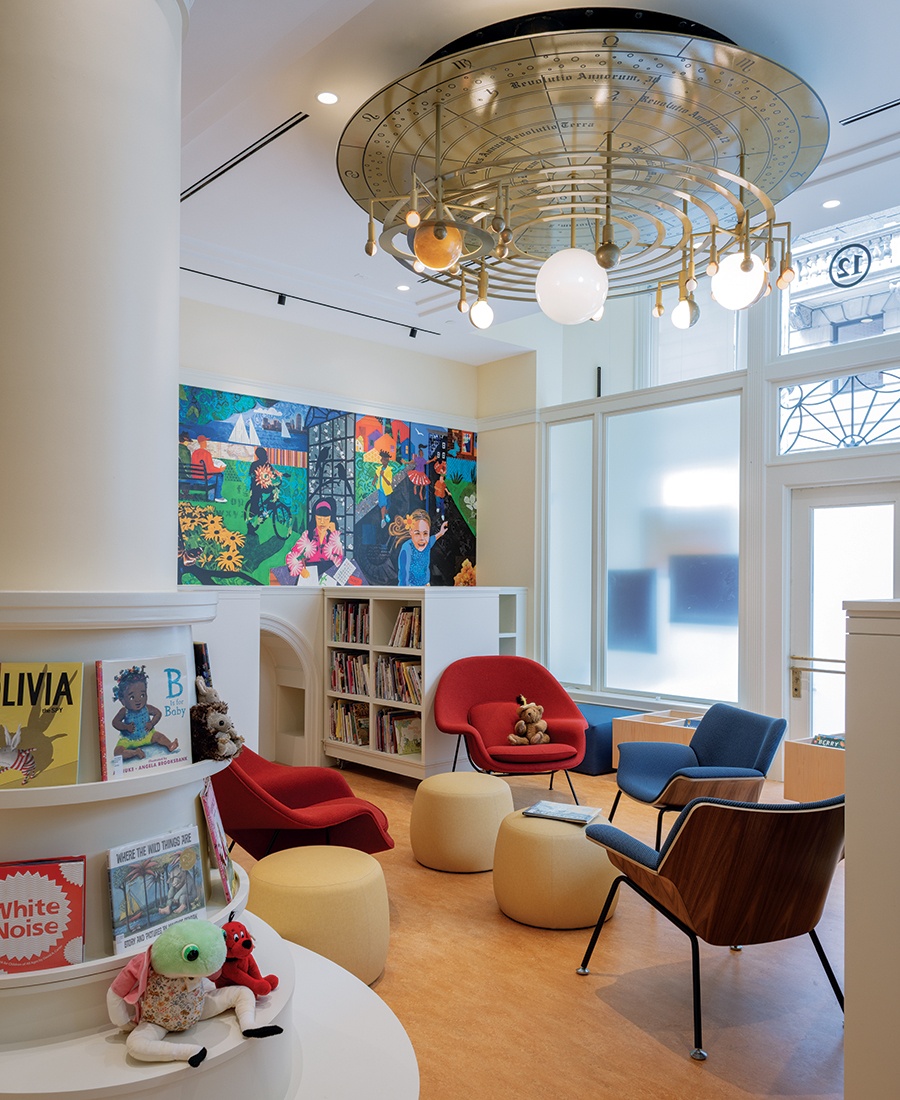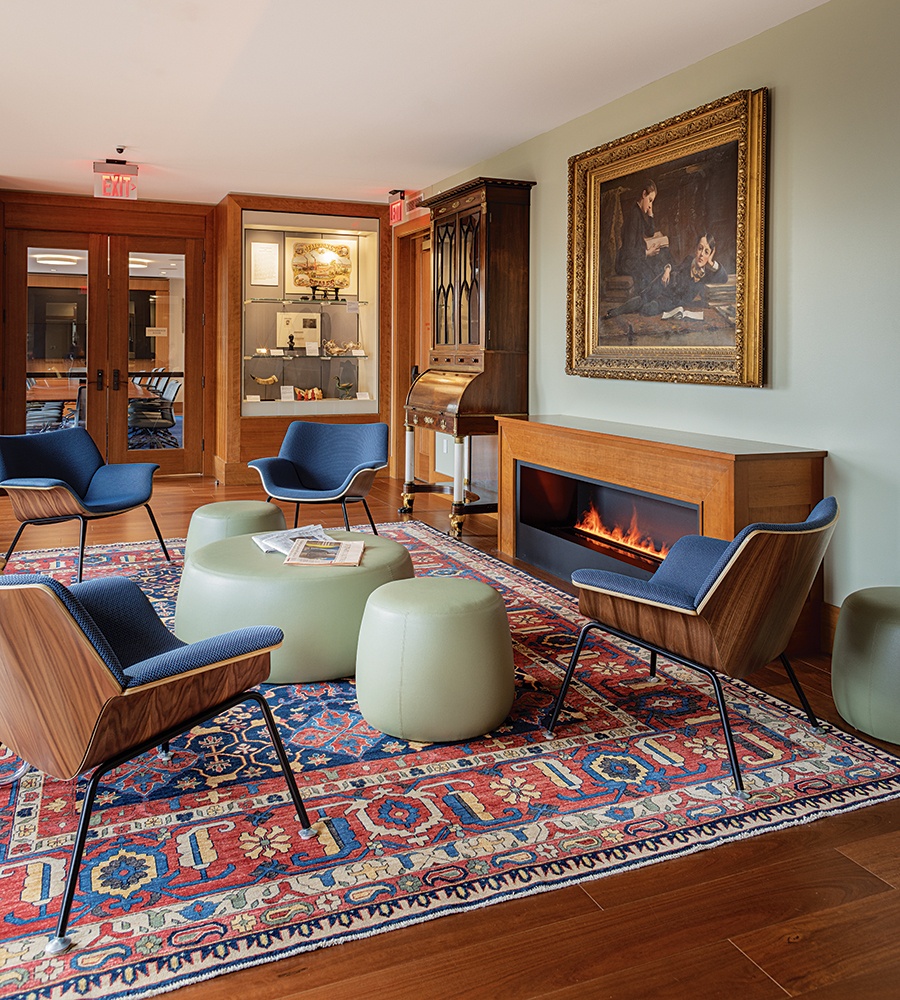What the Boston Athenaeum’s $17 Million Renovation Looks Like
An expansive revitalization makes the landmark library more interactive and inclusive while honoring its storied legacy.

Photo by Michael J. Lee
The Boston Athenaeum isn’t the inner sanctum you may think it is—although it did start out that way. Among the nation’s largest independent membership libraries and one of its first, the Boston Athenaeum was founded in 1807 by a group of local (male) intellectuals who sought an establishment where they could gather among bookshelves containing the “great works of learning and science in all languages.” The vision would expand to include a gallery of sculptures and paintings, collections of coins and natural curiosities, and even a laboratory.
Throughout the first part of the 19th century, the Athenaeum inhabited various locations in Boston. It was housed in a mansion on Pearl Street when historian Hannah Adams became the first woman to obtain membership in 1829. War correspondent Margaret Fuller joined shortly afterward, as did author—and voracious reader—Louisa May Alcott. While a chemistry laboratory never came to fruition when it was on Pearl Street, the Athenaeum added the gallery where exhibitions of American and European art appealed to the city’s cultural enthusiasts.

The Athenaeum’s outer bronze and inner red-leatherette doors were installed during the building’s renovation in 1913. / Photo by Michael J. Lee
A permanent location at 10½ Beacon Street was secured for the Athenaeum in 1847, and construction began on an Italian Renaissance–style building designed by Edward Clarke Cabot. Imposing in scale with elegant, formal detailing, the new sandstone-clad Athenaeum stood in contrast with the rest of Beacon Hill’s red brick. Architect Henry Forbes Bigelow added a fourth and fifth floor to the building in 1913, and in 2002, another renovation introduced climate control. Now, 20 years later, the building has just completed a splendid revitalization led by Ann Beha of Annum Architects.
With titles dating from the 1800s to the present, the Athenaeum has more than 600,000 books in circulation, and its special collections include 100,000 rare volumes, maps, and manuscripts—as well as 100,000 works of art. It has a vast assortment of United States government documents, publications in Native American languages, early Boston newspapers, and a significant portion of George Washington’s personal library. Several pieces of art depict General Washington’s likeness throughout the institution, including a life-size plaster sculpture by Francesco Cecchi that greets visitors upon entering the fourth floor.

The new children’s library features a newly commissioned mural by Ekua Holmes, a lifelong resident of Boston’s Roxbury neighborhood. / Photo by Michael J. Lee
The recent $17 million renovation involved a 12,000-square-foot expansion into the adjacent building, 14 Beacon. Kicking off the project was among Athenaeum director Leah Rosovsky’s first tasks when she came on board in 2020. “The critical focus was meeting our members’ needs. It was clear that they wanted more casual spaces, more places to converge,” Rosovsky says. “We were also interested in presenting ourselves as a more open and welcoming institution.”
While the Athenaeum’s traditional reading rooms are unaltered, other spaces were enhanced to maximize its cultural programming, including year-round author talks, gallery exhibitions, concerts, and social events. A new children’s library has been reimagined along with a study center designed to accommodate researchers and school groups to better engage with the Athenaeum’s materials. Living rooms provide areas for interaction, a new gallery where rotating exhibits can be experienced has been added, and a ground-level 40-seat café is slated to open later this year.
Rosovsky and the Athenaeum’s curators have also re-envisioned how the institution’s collections are presented and interpreted to reflect a more expansive view of American art and history. While a large portion of the art collection includes formal portraiture by esteemed artists, including Gilbert Stuart and John Singer Sargent, emphasis has been put on highlighting a wider range of media, including works by women and people of color. On the first floor, for example, a pair of landscapes by 19th-century Black artist Robert Duncanson take center stage, as do paintings by Bostonian Polly Thayer Starr, whose 80-year career began in the 1920s. While the Athenaeum is steeped in strong traditions, says Rosovksy, “Changing is something we’ve always done. The Athenaeum is an organization that has not stood still: We’ve changed our focus, our way of collecting, our physical space before.”

A new living room pairs contemporary seating with an antique secretary and art from the Athenaeum’s collection. A water vapor fireplace creates a realistic flame without an actual fire as fireplaces are banned from the building. / Photo by Michael J. Lee
Merging the original structure with the newly acquired space in a manner that made it feel like one unified building was integral to the project. “We started with a lot of research, which is not normally part of architectural services,” says architect Ann Beha, who, with her team, extensively studied the Athenaeum’s history. “The project was a work of preservation, interpretation, and innovation. While the space was adapted to suit the institution’s current needs and collections, we also considered the way it would provide flexibility to other generations who would want to change it.”
Fourteen Beacon’s sizable windows fill the new areas with light and views of the Granary Burying Ground. The building’s interior was a concrete space with stud walls—a stark contrast to the Athenaeum’s 19th-century moldings, cornices, and arched ceilings. Yet the palette the architects conceived of simple finishes, muted colorways, and wood floors softened by vintage carpets—many of which belonged to the Athenaeum and had been stored away—enable a seamless transition between the old and new.

The public is able to visit the Athenaeum’s first-floor spaces, including this room where oil paintings from various eras have been recently rearranged. / Photo by Michael J. Lee
On any given day, novelists, law students, readers, researchers, children, and artists can be found amid the Athenaeum’s stacks. Visitors may explore the first floor anytime, and day passes are available—and there are no exclusions regarding membership. “People are joining all the time, for all sorts of reasons,” says Rosovsky, noting that members are united by one common thread: their curiosity. “The Athenaeum,” she asserts, “is a community of the curious.”
First published in the print edition of Boston Home’s Spring 2023 issue, with the headline, “Editing Its Narrative.”


